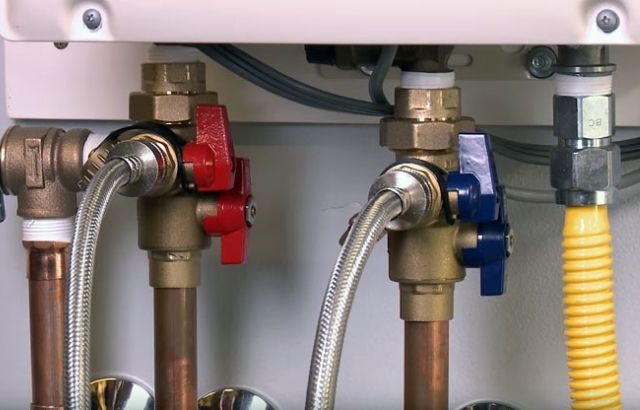Science has made life easy with modern technology and electric appliances. It is the need of an hour to know the use of these appliances. Having Tank-Less heaters in your homes is one of the examples of these appliances. First of all, you should know what the Tank-less Hot Water Heater is? This question’s answer is Tank-less water heater is also known as an in-line, instantaneous, continuous flow, flash, on-demand, or instant-on water heaters. These heaters instantly heat water as it flows through the device and does not retain any moisture internally except for the heat exchanger unit. Knowing how to flush out tank less hot water heater will help get the optimum amount of productivity and save your investment in the long run.
When you think about tankless water heaters, you may not think about tankless water heaters maintenance, but most models are unprotected to harsh minerals and residues. Let’s have a look at the process, few useful tools, and as well as essential precautions.
Importance of Flushing out Tank-less Models
Tank-less water heaters are less expensive and efficient as compared to traditional water heaters. The tank-less gas water heaters consume fewer energy levels and can save 108$ a year for heating costs. This makes them more efficient from 24% to 34%, where ever they work. The United States department of energy proved this fact.
They also need less space to operate and a low cost of maintenance. Thus, it is essential to know why, when, and how to flush out the tank-less water heaterand whether it is good to use electric heaters or gas heaters. The main benefit of using a standard tank water heater is that it can have 50% of energy savings. Therefore, the essential thing for your tankless water heater’s longevity and regular flushing is to keep it working well. It is necessary to remove sediment and mineral formation that can damage your heater. Let us walk you through the whole process in detail to give you a better idea.
Tank-less Water Heaters and Scale Build-up
Everyone who has tank-less water heaters in their homes will know the importance of flush the water heaters occasionally or regularly to remove sediments.
Tank-less models have no risk of buildup explosion but can lead to cost issues, but this does not happen in traditional tank models.
Tank-less water heaters consist of heat exchangers, which are sensitive to scale. It needs to work harder to provide hot water when limescale builds up in the unit, leading to a short life and a remarkable increase in the electricity bills. For this reason, lime buildup does not cover most warranties. There are many kinds of tank-less water heaters, it is your own choice, whether you use electric tank-less water heaters or gas heaters. They are available in 80% smaller in size than traditional water heater and have a smooth look.
When you Should Flush a Tank-less Water Heater
It would help if you flushed out your water heaters once a year regularly.
However, the hardness of water plays a vital role in this aspect. If you have a low quality of water in your homes, it will be better for you to flush your heater three times a year. A sediment trap can help fix hard water to a point and moderate value to solve hardness in the water.
Isolation Valves:
It is imperative to know about hot water valves of isolation. The isolation valve does the same activity that it sounds. The isolation valve function stops the liquid or gas supply from a portion of the pipeline without shutting off the whole supply. You might have various home appliances where you have built-in isolation valves for emergency purposes and maintenance purposes.
Moreover, these valves are available in different shapes and modifications, like rotatory movement valves and linear movement valves. You can hire the services of experts and professionals to install these valves in your heaters, as it is a significant safety component in it. They usually take the service charges upto300$ to 400 $ for cleaning tank-less water heater.
Using Pumps and Flush Kits:
One of the best options for flushing a tank-less water heater is to use the submersible pump. You don’t need a large quantity of water to swing up and pull the sediment out, like tank heaters.
So if you opt for a good quality sump pump like 91250 from the superior pump, it will reduce the cost to flush a tank-less water heater and saves time. You will need a big bucket for flushing, as there is no drainage system in the submersible pump, but it is present in the average model pump.
Another vital tool is the navien tank-less water heater flush kit. This kit contains all-important accessories like a pump, descaler, bucket, and hoses.
How to Flush Out a Gas Tank-less Water Heater?
You should check the manual of your water heater to follow the necessary instruction. Whether you use a gas heater or an electric water heater, you should follow some instructions in sequence.
Step 1: Preparation:
- Disconnect the electric supply from the heater.
- Use a non-contact voltage tester to check the power supply going to terminals, and remove the access panels.
- Close and locate the gas supply valve.
- While working, locate and close the hot water service and cold water supply valve to prevent water goes into the unit.
- Mark the hot water pressure relief valve located on the hot water line; open it to discharge any pressure.
- Connect the hoses of both cold water and hot water service port.
- Put the submersible pump in the 5-gallon pump.
- Connect the pump to the cold water hose.
- In the bucket, place the free end of the hot water hose.
- Mix 4 gallons of white vinegar in the bucket.
Step 2: Flushing:
- Turn on the pump and open hot and cold services ports of water.
- Circulation of vinegar through the heater is necessary for at least one hour to remove sediment from the unit.
- First, scrapyard the vinegar, and then power off the pump.
- Removal of attached hose and closing of cold water supply should be done.
- To flush out the remains of vinegar from the second hose, open the cold water shut off valve.
- Now close the cold water valve.
- For draining, allow water to go to the second hose as well.
- Switch off the hot water service port.
- Remove XSD34Yhot water in-line filter and cold water inlet filter.
- To remove the extra sediment residue, flush the filters into the sink.
Step 3: Cleaning:
- Replace excess panel and filters, open the hot and cold water shut off valves.
- Reconnect the electrical supply and open the gas shut-off valves.
So this is all about how to flush out a tank-less water heater? Moreover, they show maximum efficiency if a thin layer of scale is present in them, increasing the energy costs up to 30%.
If you follow these steps, you can easily flush out a tankless water heater.
Thus performing the simple steps for flushing out water heaters can improve its overall life and durability. Tankless water heaters are a beneficial invention compared to tank-based heaters but provide an unlimited amount of hot water to users.
How to Flush Out a Tankless Hot Water Heater: FAQs
How do you flush a tank-less water heater?
It would help if you opened the cold and hot isolation valves of the water heater. Do turn on the pump in the 5 gallons bucket to circulate vinegar through the heater; it should be distributed for 45 minutes. Then turn off the pump and put the vinegar to drain from the water heater through the hoses into the bucket. The flushing tankless water heater with vinegar turns it blue.
Do tankless water heaters need to be flushed?
Yes! Tank-less water heaters should be flushed at least once a year regularly to remove the excess amount of calcium and other minerals within the unit, especially if you have hard water in your homes.
How much does it cost to flush a tank-less water heater?
The professionals and experts must do the repairs for sure. The average cost of flushing out the tankless water heaters is approximately about $150 to $800 and can also float up to $600. It needs to flush out the minerals and sediments at regular intervals for greater efficiency and longevity.
Types of Tankless Water Heaters by Fuel
Generally, there are three types of tankless water heaters available in the market: Electric, Gas, and Propane-powered.
Electric Tankless Water Heater
This type of heater is very inexpensive, and the initial investment cost and running cost is relatively low. And above all electricity is easily available in your home. However, you might need to install heavy electric cables in your house.
Natural Gas Tankless Water Heater
The natural gas heaters cost somewhat moderate, but gas combustion contributes heavily towards the greenhouse effect. And also, they need frequent maintenance. Also, you may need ga pipes and proper venting for this heater.
Propane Tankless Water Heater
The propane-powered tankless water heaters are environmentally friendly, but you might need a propane fuel tank if you don’t want to use the pipes. Again the installation cost and running cost of this heater is lower than the gas heater.
Conclusion
To end the topic, how to flush a tankless water heater, I will say that it is indeed a somewhat complicated process and necessary to get the optimum efficiency and productivity. Tankless water heaters are best as they heat water on demand rather than store them in tanks, leading to considerable energy savings. Therefore like other home appliances, if you take care of tools and precautions, your tankless water will perform more efficiently, and less maintenance and repair will be needed. So if you follow the above steps and protection, your tankless water heater will work well.
Read More: How To Increase Water Pressure From Rain Barrel




